Work
Coenen's professional career started off with relatively small scale architectural projects, the majority of which were in the south of the Netherlands. This includes the public library in Heerlen (1983-1986), the city hall of Delft (1984-1986) and a bank in Venlo (1984-1987). His reputation began to grow with larger scale urban design work, including the area around the Vaillantlaan in The Hague, the KSNM island in Amsterdam, the Céramique residential area in central Maastricht and the Maas-Marktproject, also in Maastricht. The large scale and complexity of these projects also helped develop his international reputation. [4]
Other larger projects designed by Coenen include The Dutch Architecture Institute (originally called the Het Nieuwe Instituut) in the Museumpark of Rotterdam (1988–1993), the Smalle Haven area in Eindhoven (which includes the construction of the Vestedatoren, 2000–2006) en the Innovatoren in Venlo (2009-2011). Coenen's office (Jo Coenen Architects and Urbanists of JCAU) was one of the two architectural firms that (the other firm was Network Oriented Architects, NOAHH) worked on the (second) design for the education and cultural complex Amare in the centre of Den Haag (2015-2021). [5] However, this commission was not an easy project and featured conflict with the council in Den Haag. [6]
JCAU-desgined buildings are characterised by their awareness of their urban surrounding, with a focus on the public space around the building. They are also characterised by design thinking at a macro and micro level - from the building's overall place in the city, to the furniture within it. Coenen's work is described as being ‘friendly monumentalism. [7] , and "literal and figuartive heavyweights compared to the 'hip' design trends, ironic distance and radical experiments" of other Dutch architects. [8] Within the Dutch architectural community, Coenen argues for greater understanding and sensitivity of deeper historical patterns in architecture. Both in his urban planning projects and his time as rijksbouwmeester, he has demonstrated a strong preference for Belgian, Swiss and souther European architects. For the development of the KNSM-elsand he worked with Bruno Albert and Diener & Diener, for the Céramique with Bruno Albert, Charles Vandenhove, Bob Van Reeth, Christian Kieckens, Mario Botta, Luigi Snozzi, Aldo Rossi, Cruz y Ortiz, MBM Arquitectes and Álvaro Siza, [9] For the Mosae Forum Bruno Albert was again involved. As rijksbouwmeester he nominated Juan Navarro Baldeweg as the architect for the RCE-gebouw in Amersfoort. [10]
At the end of 2021 Coenen launched, together with the Belgian-Dutch economist and ex rector of the University of Maastricht, Luc Soete, for the partial tunnelling of the main railway tracks in Maastricht. The plan was presented in an exhibition in 2022 at the Centre Céramique. After it gained support from the council in Maastricht, a request went to the ProRail for a feasibility study. [11] After initial negative feedback from ProRail, who considered it too expensive, a second plan was submitted. This proposed a complete tunnelling of the railway lines - the potential exploitation of more ground-level land meant that the project was financially more sustainable. [12]
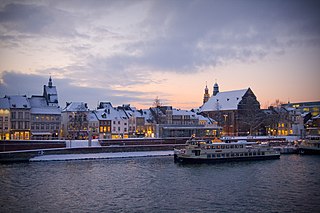
Maastricht is a city and a municipality in the southeastern Netherlands. It is the capital and largest city of the province of Limburg. Maastricht is located on both sides of the Meuse, at the point where the Jeker joins it. Mount Saint Peter (Sint-Pietersberg) is largely situated within the city's municipal borders. Maastricht is adjacent to the border with Belgium and is part of the Meuse-Rhine Euroregion, an international metropolis with a population of about 3.9 million, which includes the nearby German and Belgian cities of Aachen, Liège, and Hasselt.
This article is intended to give an overview of telecommunications in the Netherlands.

Heerlen is a city and a municipality in the southeast of the Netherlands. It is the third largest settlement proper in the province of Limburg. Measured as municipality, it is the fourth municipality in the province of Limburg.

De Bijenkorf is a chain of high-end department stores in the Netherlands, with its flagship store on Dam Square in Amsterdam. The chain is owned by Selfridges Group, owner also of Britain's Selfridges and Ireland's Brown Thomas and Arnotts.
The Museum Card, also known as the Museumkaart in Dutch, is a personal card that grants free entry to approximately 400 museums in the Netherlands for one year. It is available for purchase at many of the larger participating museums or online, with a temporary card issued when purchased from the museum. While most museums offer free entry to Museum Card holders, some museums may charge an additional fee for special exhibitions, but not for general collections.

N. John Habraken was a Dutch architect, educator, and theorist. His theoretical contributions are in the field of user participation in mass housing, the integration of users and residents into the design process. The visual result of his theory is the architecture of lively variety. Habraken was the initiator of the international "Participation movement" in architecture. His book Supports: An Alternative to Mass Housing, first published in 1961, is the manifesto and starting point of this movement. The theme resident or user participation has been linked to Structuralism and open building.

The Netherlands Architecture Institute (NAI) was a cultural institute for architecture and urban development, which comprised a museum, an archive plus library and a platform for lectures and debates. The NAI was established in 1988 and was based in Rotterdam since 1993. It ceased to exist in 2013, when it became part of Het Nieuwe Instituut.
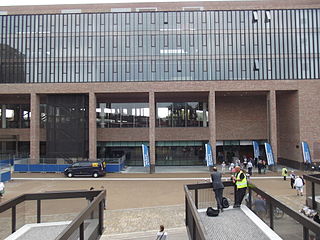
Breda railway station is a railway station in Breda in North Brabant, Netherlands. It is situated on the Breda–Rotterdam railway, the Roosendaal–Breda railway and the Breda–Eindhoven railway.

Rotterdam Centraal station is the main railway station of the city Rotterdam in South Holland, Netherlands. The station received an average of 112,000 passengers daily in 2019. The current station building, located at Station Square, was officially opened in March 2014.
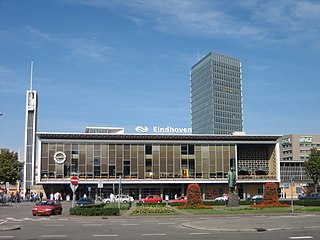
Eindhoven Centraal railway station is the main railway station in Eindhoven in North Brabant, Netherlands. It is the busiest station outside the Randstad area and an important station in the southern part of The Netherlands.

Gerard Caris is a Dutch sculptor and artist who has pursued a single motif throughout the course of his artistic career, the pentagon.
Wiel Arets is a Dutch architect, architectural theorist, urbanist, industrial designer and the former dean of the college of architecture at the Illinois Institute of Technology in Chicago, in the United States of America. Arets was previously the 'Professor of Building Planning and Design' at the Berlin University of the Arts (UdK), Germany, and studied at the Technical University of Eindhoven, graduating in 1983. The same year later he founded Wiel Arets Architects, a multidisciplinary architecture and design studio, today with studios in Amsterdam, Maastricht, Munich, and Zürich. From 1995-2002 he was the dean of the Berlage Institute in Rotterdam, where he introduced the idea of 'progressive-research' and co-founded the school's architectural journal named HUNCH.

Maarheeze is a railway station in Maarheeze, The Netherlands.

The KNSM Island is a man-made island in the Eastern Docklands of Amsterdam. KNSM stands for the Koninklijke Nederlandsche Stoomboot-Maatschappij, the Royal Dutch Steamboat Shipping company which used to have its headquarters and its docks on the island. It is now a large residential area containing modern architecture with a mostly well-off population.
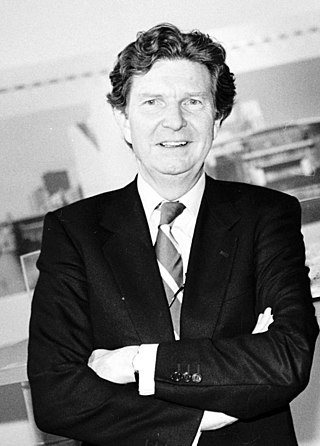
Hubert-Jan Henket is a Dutch architect. He is a specialist in the relations between old and new buildings, the redesign of buildings, renovation and restoration. He is the founder of DOCOMOMO international.
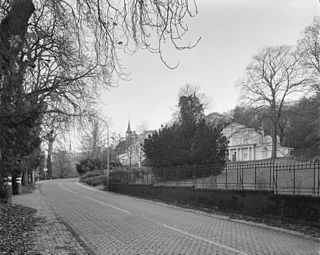
Rijksstraatweg or simply Straatweg was the term for paved roads of interregional significance in the Netherlands in the 19th and early 20th centuries. These roads were built by the national government, and formed the country's first centrally planned highway network. They received route numbers, eventually resulting in a nationwide network of 82 highways. It formed the basis for today's system of nationally controlled roads, the Netherlands' main highway grid.
Piet Gerards is a Dutch graphic designer and publisher.

Charles Hubert Eyck was a Dutch visual artist. Together with Henri Jonas and Joep Nicolas, he was a pioneer of the Limburg School.





















